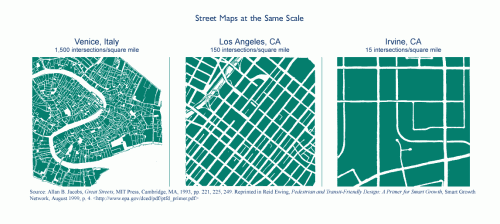Intersection density is the number of intersections in an area. It corresponds closely to block size — the greater the intersection density
, the smaller the blocks. Small blocks make a neighborhood walkable. This diagram shows three street layouts — extremely walkable, moderately walkable, and unwalkable — with their counts of intersections per square mile:
Intersection density makes surprising news in a study by the formidable academic duo of Reid Ewing and Robert Cervero. They have published Travel and the Built Environment: A Meta-Analysis in the Summer 2010 issue of the Journal of the American Planning Association.
As the title notes, the study is a meta-analysis: a study of 50 other studies about travel and the built environment. The authors look at the results from each of the 50 studies
, and then pool all of those results into ten built environment measurements, including intersection density.
Their findings? Of all the built environment measurements, intersection density has the largest effect on walking — more than population density, distance to a store, distance to a transit stop, or jobs within one mile. Intersection density also has large effects on transit use and the amount of driving. The authors comment,
This is surprising, given the emphasis in the qualitative literature on density and diversity
, and the relatively limited attention paid to design.
In other words, intersection density is the most important factor for walking and one of the most important factors for increasing transit use and reducing miles driven, but gets relatively little attention in research and in public policy.

